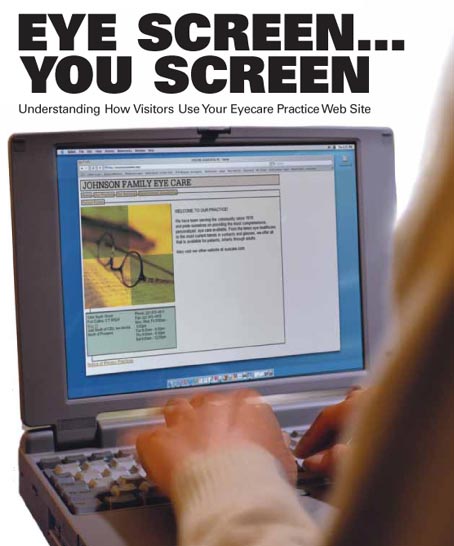
By David M. Pearce
Over the past several years, I have seen eyecare practice web sites go from four page, basic information sites to 100-page, here’s everything you need to know about eyecare sites. Conventional wisdom (and the recommendations from more than a few consultants) said that patients want information and by making that information available on your practice web site, you strengthened your position as an expert and trusted source.
Most private eyecare practitioners have an idea of how they want people to use their eyecare practice web site. It would be great if your patients and potential patients used your site as the definitive resource for all eye health/vision-related questions. This would solidify your position as a leading expert in your market, which should help bring in new patients. In theory, this would seem to make sense. However, my experience tells me otherwise. As an editor for the Open Directory Project, the largest, most comprehensive human-edited Internet directory— www.dmoz.org, I have reviewed hundreds of eyecare practice web sites. So, in order to get a better understanding of how visitors actually use an eyecare practitioner’s web site, I recently completed an analysis of the web traffic reports from five different, unrelated eyecare practice web sites.
The web sites were all practice sites for one to two OD, single-location private practices located in geographically dispersed suburban communities. My analysis covered more than 500,000 page views over a two-year period. For comparative purposes, I also analyzed the traffic patterns of more than 500,000 visits to an online retail consumergoods seller over a two-year period. My conclusions are likely to surprise a few people.
The average visit consisted of three page views. This number by no means implies that the average visitor viewed three pages. The overwhelming majority of visits consisted of a single page view—the visitor clicked on a link that took them to the site and then they immediately hit the back button. Either the link didn’t take the visitor where they expected it to or the landing page didn’t seem to have what they were looking for. Either way, this result has important implications.
Most web site owners are focused on getting more traffic to their site. Generally speaking, more traffic is better than less traffic. However, it is important not to lose sight of the quality of the traffic and how you are converting the traffic you already have. Tracking web site visitor activity is essential to improving a site’s functionality and subsequently its usefulness.
New visitors (potential new patients) usually come to an ECP site looking for information to help them make a selection decision: Where is the practice located; what are its hours; what insurance is taken; how experienced is the doctor. Once they’ve reviewed this basic information, most visitor leave the site. Few return for multiple visits.
On average, the five sites I studied received 65 visits per day (based on a seven-day week), with approximately 70 percent of the visits coming from new/first-time visitors. Imagine getting 45 prospective new patient phone calls every day—including Saturdays and Sundays. While these visitor numbers are not bad, a well-planned, well-executed Internet marketing strategy could double visitors and visits.
 Remember though, that approximately 70
percent of these visitors visited only one page
and spent less than 30 seconds on that page.
The three most visited pages, aside from the
“Home” page, were “About Us,” “Hours
and Locations” and “Our Doctors/Staff.” In
total, less than 1 percent of the page views I
reviewed were visits to condition-specific,
vision encyclopedia-type pages.
Remember though, that approximately 70
percent of these visitors visited only one page
and spent less than 30 seconds on that page.
The three most visited pages, aside from the
“Home” page, were “About Us,” “Hours
and Locations” and “Our Doctors/Staff.” In
total, less than 1 percent of the page views I
reviewed were visits to condition-specific,
vision encyclopedia-type pages.My research indicates the macro-level consumer- initiated medical research is indeed done online, but generally at web sites such as Wikipedia, All About Vision or the Mayo Clinic. While I do not discourage the inclusion of these type of encyclopedic pages into your practice web site, I do not agree that these pages are a must have… particularly for the relatively low ROI they will provide. Consider treating your practice web site as if it was a retail site and a “visitor conversion” directly resulted in a profitable sale. Equate a new site visitor that submits an online form giving you contact information for that potential new patient with a qualified lead that you can cultivate and convert to a revenue-generating patient. By focusing on “conversions” you can more effectively manage the visitor flow through your site and create funnels to get visitors to the “action items” in a manner that encourages them to convert.
To fully optimize the online conversion, it takes dedicated offline follow-up. Part of my research for this project included filling out various online contact forms from the practices in my study. Three never responded in any way to my request for contact. I image they must be booked solid or in desperate need of help. On the other extreme, I had one practice that called me back within 15 minutes. Wow! Now that is what I call a great first impression.
So, while getting more traffic to your site is important, getting the most from the traffic you already have should take top priority. Focus on visitor conversion improvements first, then and only then should you worry about increasing traffic -LT
David M. Pearce, NCLEC, is president of Responsible Marketing Consulting Services in Plattsburg, N.Y. He is a well-known eyecare industry author, lecturer and Internet marketing expert. For more information on marketing your eyecare practice on the Internet, go to www.resmarkconsulting.com. Mr. Pearce can be reached at [email protected].













